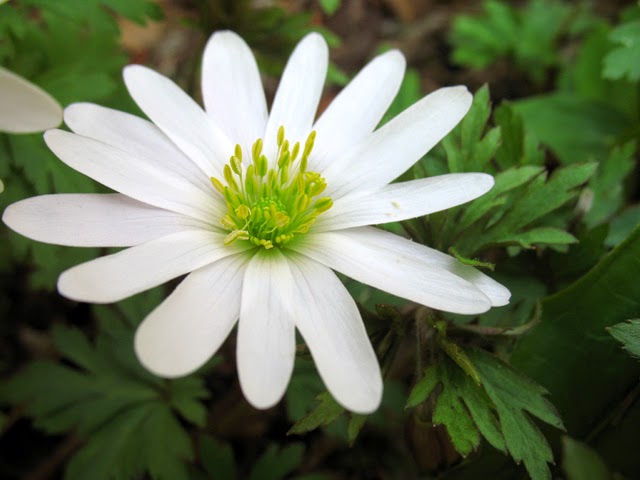Anemone - Grecian Windflower
 |
| Anemone blanda White Splendor |
They are positively delightful to plant near dwarf daffodil varieties such as March Sunshine and Rapture since they bloom around the same time and are about the same height - 6 to 12-inches, creating a sweet bouquet of their own.
Once they get started, Anemones can bloom for a month. If they like their new home they can spread by seed but mine never have. They do hang and in there and bloom for several years but they have never spread for me.
They are cold hardy to zone 5 and do well up to zone 8. Old House Gardens says the White Splendor was introduced in 1950 when it won an RHS award as "the strongest growing and dazzling"
Choose a spot in bright half-sun or half-shade, plant the corms on their edge in well-draining soil. I surround them with a little trough of perlite to help them not drown since our normal rainfall is over 40-inches annually.
I dig the hole 4 inches deep, put in an inch of perlite and then settle the corms, covering them with some native soil mixed with more perlite, about 70 percent soil to 30 percent perlite.
Like crocus bulbs, anemones are relocated by squirrels so protection is helpful. For crocus I use plastic berry baskets. For anemones I've found that topping the planting area with rocks from around the yard is enough to keep them from digging.
 |
| Anemone blanda White Splendor |
They can also be forced for winter flowering by re-creating nature's process of chilling and warming them.
To force anemone corms -
1. Soak for a few hours in warm water.
2. Put horticultural grit (small stones or pea gravel) in the bottom of a container with holes.
3. Mix compost with more grit or potting soil with perlite to fill container 2/3 full.
4. Place anemone corms on top. One reference says that flat edge you see in the photo of my corms is where the leaves emerged last season so it would be planted up. Another resource says plant the point up. If you need to know which side goes up you can plant them 2-inches deep in moist sand and check them in a week or two. You will be able to see where the roots have grown.
5. Cover corms with more compost or sterile potting soil. Moisten thoroughly.
6. Put in cold, dark spot and check weekly so they don't dry out. Never let them stay soaking wet.
7. When leaves begin to emerge, place in warm, bright light.
By the way, Anemones are in the Ranunculaceae or Buttercup plant family, along with
Clematis, Delphiniums, Nigella, Lesser Celandine and Helebores - ergo their preference for part-shade.
They are native to more than Greece even though their name is Grecian Wind Flower. They also are naive to Turkey, Lebanon and Syria.
According to MOBOT's Plant Finder they tolerate black walnut trees and are not eaten by deer. Good news for many gardeners!



Comments